Saints for Today
Linda Schwarz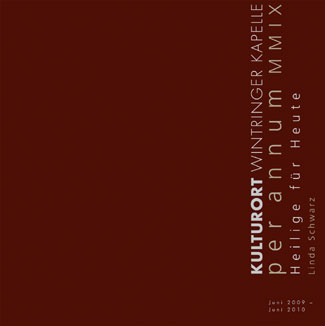
There is an interaction between the suggestive power of the former saints of Wintringen and my images of the saints of today. The saints of yesterday provide an order, they guide the imagination, they stimulate the exploration of spaces, which I have discovered as a starting point for my own work.
Linda Schwarz
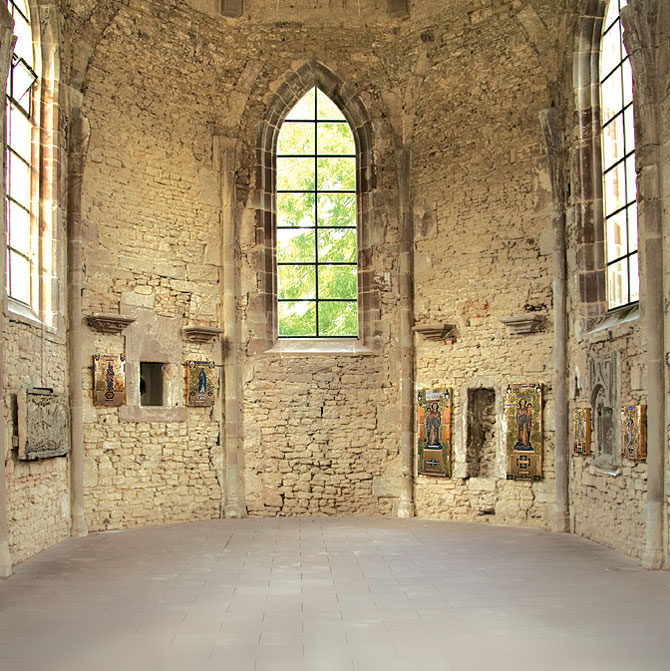
Prologue
Why Saints for Today? The artist Linda Schwarz has been working for several years on the reinterpretation and updating of yesterday's saints. What has taken their place? The "Wintringer Madonna", now kept in the castle church in Saarbrücken, vividly represents the high level of artistic creativity that was once cultivated in the region, as do the structural relics of the former Premonstratensian monastery, which have been reduced to a chapel. From 1800, heavy industry dominated the region for more than two centuries. During that time, the Wintringen chapel eked out a dreary existence as a barn (the saints "of yesterday" parked in the attic). At the end of the 20th century it finally received a new, suitable function as a cultural place. Today it is one of the few places in the still young European (large) region, which is increasingly defining itself as a common cultural space, where artistic intervention and the examination of cultural values in their versatility are desired. In this way, it contributes to the new identity of the region - also as a tourist destination. The exhibition project "Saints for Today" is a convincing contribution to regional development as a symbiosis of art, architecture and history, of public and civic engagement.
Eva Mendgen, Saarbrücken in June 2009
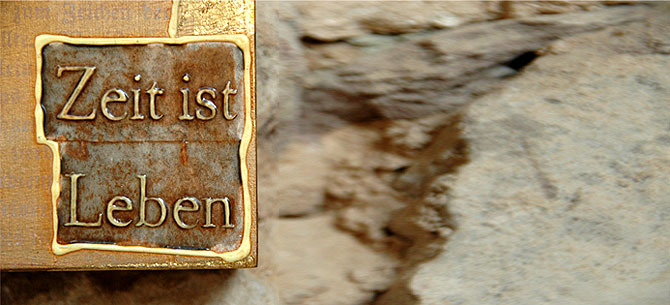
Saints of Yesterday
Presumably, the choice of this patrocinium goes back to the mother monastery of the Premonstratensians in Wadgassen, founded in 1135. The most prominent figure of a saint still preserved today, which belonged to the furnishings of the late Gothic church in Wintringen, is the "Wintringer Madonna" made of lime wood. It was probably created around 1480 and is now exhibited in the museum in the castle church in Saarbrücken for conservation reasons. This late Gothic wooden sculpture is a rare piece and stylistically refers to the Lorraine and Upper Rhine art, which the sculptor Nikolaus Gerhaerts von Leyden significantly influenced.
The "Wintringer Madonna" probably had its location on the altar, but possibly also on one of the figure consoles still recognizable today. Four of these stone consoles are located on the closed end walls. The remaining consoles are still recognizable on the worn ashlars on the two longitudinal walls of the choir loft.
Also preserved on site is a wall relief in limestone, a whole picture program from the 16th century, probably a pilgrimage. At the top left of the picture is recognizable the Holy Mary, flanked by two angels taken up to heaven.
A later figure of the saint, probably created in the 17th century, St. Anthony, is today in the parish church of St. Agatha in Kleinblittersdorf. An inscription refers to the origin of the saint from the Wintringen chapel. Antonius, father of occidental monasticism, is also marked with the attributes of a (St. James) pilgrim - the broad-brimmed hat and the pilgrim's staff. The worldview behind this is the Augustinian notion of ceaseless human pilgrimage.
During the archaeological excavations inside the former priory church of Wintringen, in addition to the small fragment of a Corpus Christi made of terracotta (probably 17th century), another representation of a saint came to light, which also refers to Wintringen as a former place of pilgrimage. It is a baroque silver medallion in oval form, a piece of jewelry whose front side shows the standing Mother of God with Child, accompanied by two angels, and whose back side shows a kneeling saint who cannot be clearly determined. Four other saints date from the early 18th century and are now in the Kuchlingen Chapel in Auersmacher. The storage book of the parish of Auersmacher states that the parish priest Friedrich Josef Mathey took these figures to Auersmacher in 1819 with the consent of the owner of the Wintringer farm, Wilkreuz, in order to make them accessible to the faithful there again: the sculptures were deposited in the attic of the Wintringer Chapel at that time. They were the Mother of God, a Saint Paul, a Saint Peter, as well as two female saints and probably a Mary Magdalene, possibly also a Saint Anne (probably both 19th century).
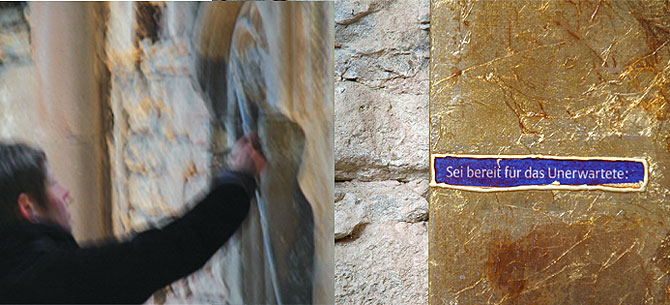
Saints for Today - work-in-progress
On invitation Linda Schwarz visited the Wintringer Chapel for the first time in 2008. She asked herself which saint(s) could be at home in the chapel in the here and now. By June 2009, nine wooden panels had been created, their format matched to that of the striking "niches" in the masonry - sacrament houses that had become functionless - and then hung with spatial reference to these niches, as it were, as "triptychs". The panels took up the (no longer present) "saints of yesterday" of the chapel in a new interpretation, working with the whole range of craft and artistic means, from traditional to ultra-modern. Titles and text fragments cut out of advertisements and daily newspapers and collaged onto the panels establish references to the present. If the figures of saints, as old acquaintances in a new interpretation, inspire us to pause, it is the cleverly combined texts that initiate an individual communication between the work of art, its viewer and the context of his or her life, and challenge the viewer to sharpen his or her own thoughts.
Linda Schwarz's work explores one facet of the tension between the sacred and the profane, the everyday and the spiritual. Are saints perhaps also people who we encounter today so very inconspicuously and who carry and pass on their message with their self-conception of a meaningful life?
For a whole year, until the summer solstice 2010, visitors to the cultural site Wintringer Chapel will be able to gain new insights and visual experiences.
Triptych 1
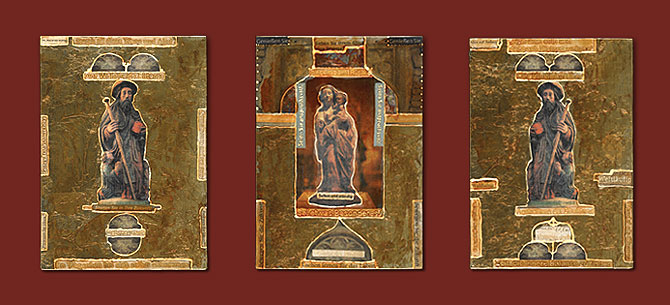
Three little saints, 35 x 24 x 6 cm
The three small panels are hung in the form of a triptych as an optical continuation of the eaves basin in the west wall of the chapel in a bricked-up portal framed by a pointed arch. On the left is St. Anthony, in the center the "Wintringer Madonna", on the right St. Anthony side-inverted.
Triptych 2
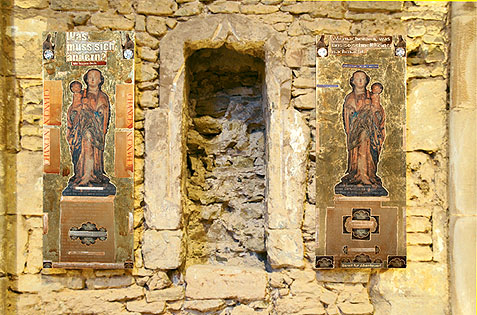
Two large saints, 130 x 49 x 6 cm
The two large panels show the "Wintringer Madonna" twice, once side-inverted, they are hung in the apse, left and right of the former lavabo.
Triptych 3
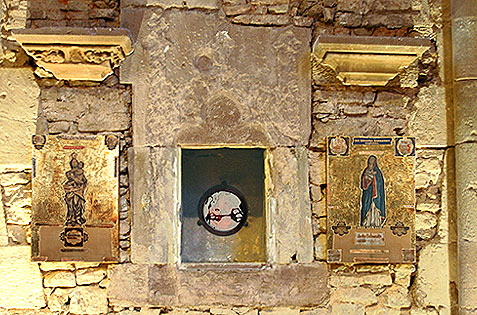
Two medium-sized saints (ladies), 66 x 45 x 6 cm
The two medium-sized panels show two female saints, Mary as Queen of Heaven and Saint Anne (?), hung in the apse, to the left and right of the former sacramental niche.
Triptych 4
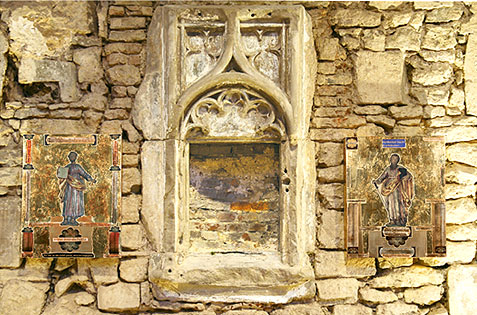
Two medium-sized saints (men), 56 x 44 x 6 cm
The two medium-sized panels show two male saints, Peter and Paul, hung in the apse, to the left and right of the wall shrine, a spolia of unknown origin.
Triptych 1
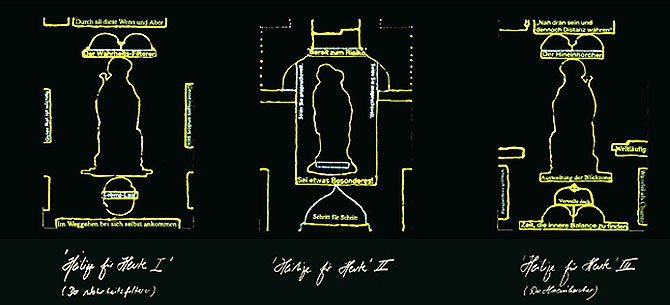
Saints for day and night: the outlines of the figures and the lettering are traced with fluorescent green pigment, they absorb the UV light and glow in the darkness
Linda Schwarz
The artist Linda Schwarz, born in 1963, studied in Stuttgart, at the HdK Berlin and as a scholarship holder of the Evangelisches Studienwerk at various universities in the USA. For one year she worked at the renowned art printing house ULAE (New York) with Robert Rauschenberg and Jasper Johns. Schwarz uses and develops new experimental printing techniques, which she combines with conceptual pictorial objects such as characters or manuscripts of music and literature. She has lived at Schloss Homburg near Würzburg since 1999 and near Straubing since 2008.
www.lindaschwarz.deDr. Eva Mendgen
The art historian Dr. Eva Mendgen, born in 1959, completed her studies in art history, ancient history and comparative religion in 1991 with a doctorate in Bonn. She made a name for herself internationally as an exhibition organizer and publicist, and was responsible for the book on the European Capital of Culture "Im Reich der Mitte / Le berceau de la civilisation européene - Savoir-faire, Savoir-vivre" (Saarbrücken/Konstanz 2007). In 2006 she founded the cultural network and ideas laboratory "regiofactum".
www.mendgen.comLinda Schwarz and Eva Mendgen got to know each other as lecturers at the HBK Saar in 1997 during a workshop for "Experimental Printing Techniques" and worked closely together for half a year in the realization of the exhibition project per annum MMIX.
Original sound
The texture of per annum also includes the involvement of musicians, performers, photographers. Isabel Gehweiler on cello and Felix Hubert on double bass have reflected the works of Linda Schwarz with their own compositions and improvisations.
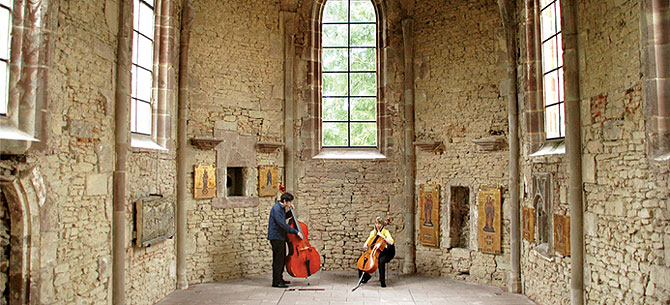
In cooperation with the AV Media Center of the Regional Association Saarbrücken and with the kind support of the director Hans Bender, the positions of the artists Linda Schwarz and Dr. Eva Mendgen and the two musicians were recorded on site.
For per annum Philipp Simon, camera/









